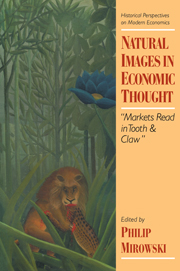Book contents
- Frontmatter
- Contents
- List of contributors
- Acknowledgments
- Part I The Natural and the Social
- Part II Physical metaphors and mathematical formalization
- 3 Newton and the social sciences, with special reference to economics, or, the case of the missing paradigm
- 4 From virtual velocities to economic action: the very slow arrivals of linear programming and locational equilibrium
- 5 Qualitative dynamics in economics and fluid mechanics: a comparison of recent applications
- 6 Rigor and practicality: rival ideals of quantification in nineteenth-century economics
- Part III Uneasy boundaries between man and machine
- Part IV Organic metaphors and their stimuli
- Part V Negotiating over Nature
- Index
6 - Rigor and practicality: rival ideals of quantification in nineteenth-century economics
Published online by Cambridge University Press: 19 January 2010
- Frontmatter
- Contents
- List of contributors
- Acknowledgments
- Part I The Natural and the Social
- Part II Physical metaphors and mathematical formalization
- 3 Newton and the social sciences, with special reference to economics, or, the case of the missing paradigm
- 4 From virtual velocities to economic action: the very slow arrivals of linear programming and locational equilibrium
- 5 Qualitative dynamics in economics and fluid mechanics: a comparison of recent applications
- 6 Rigor and practicality: rival ideals of quantification in nineteenth-century economics
- Part III Uneasy boundaries between man and machine
- Part IV Organic metaphors and their stimuli
- Part V Negotiating over Nature
- Index
Summary
Neoclassical economics, now dominant in the English-language world, emerged out of the so-called marginal revolution beginning in the 1870s. In retrospect, and in the eyes of some of the leading protagonists as well, it seems clear that the crucial change here was nothing so limited as a new theory of value. It was the serious introduction of mathematical reasoning to economics. It is only a slight exaggeration to say that mathematical methods constituted economics as an academic discipline. This conquest of economics by mathematics has become the most lively and exciting area of research in the current history of economics. On the whole, historians of this episode have come to agree with the actors themselves, that the model of the natural sciences contributed crucially to the reformulation of economics. To say this is by no means necessarily to praise neoclassical economics. While economists generally consider their ties to physics a matter to celebrate, historians often have not. Thus, many are inclined to blame inappropriate copying of physics for the willingness of neoclassicals to tolerate bizarrely unrealistic assumptions and to place everything historical, cultural, institutional, and even psychological outside the framework of economic analysis. One of the least sympathetic portraits, by Philip Mirowski (1989), indicts neoclassical economics precisely for its unimaginative copying of energy physics. If true, it is easy to understand why economic assumptions and models might seem to caricature the motives and behavior of real, flesh-and-blood human actors.
I take it as well established now that the model of natural science played a key generative role in the creation of mathematical economics.
- Type
- Chapter
- Information
- Natural Images in Economic ThoughtMarkets Read in Tooth and Claw, pp. 128 - 170Publisher: Cambridge University PressPrint publication year: 1994
- 20
- Cited by

